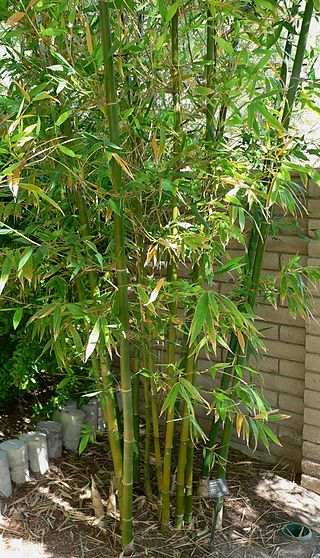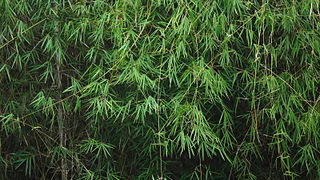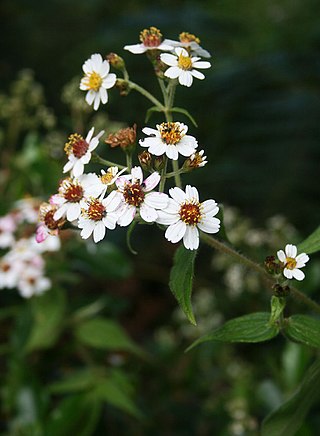
Bambusa is a large genus of clumping bamboos. Most species of Bambusa are rather large, with numerous branches emerging from the nodes, and one or two much larger than the rest. The branches can be as long as 11 m (35 ft).

Chusquea is a genus of evergreen bamboos in the grass family. Most of them are native to mountain habitats in Latin America, from Mexico to southern Chile and Argentina.

Clethra is a genus of flowering shrubs or small trees described as a genus by Linnaeus in 1753.

Tetrorchidium is a genus of flowering plants in the family Euphorbiaceae first described in 1841. It is native to tropical portions of Africa and the Western Hemisphere.

Atractantha is a South American genus of bamboo in the grass family, native to Brazil, Colombia, and Venezuela.
- Atractantha amazonicaJudz. & L.G.Clark - Amazonas in Brazil, Amazonas in Venezuela, Vaupés in Colombia
- Atractantha aureolanataJudz. - Espírito Santo, Bahia
- Atractantha cardinalisJudz. - Bahia
- Atractantha falcataMcClure - Bahia
- Atractantha radiataMcClure - Bahia
- Atractantha shepherdiana – Athroostachys shepherdiana

Rhipidocladum is a genus of New World woody bamboo in the grass family. It is found in Mesoamerica, Trinidad, and South America. The genus is characterized by having erect, non-pseudopetiolate culm leaves, numerous branchlets arising in an aspidate (fan-like) array, and by having true caryopses as fruit. The name is derived from the Greek rhipid meaning "fanlike" and clad meaning "branch".
- Rhipidocladum abregoensis - Colombia
- Rhipidocladum ampliflorum - Venezuela
- Rhipidocladum angustiflorum - Colombia, Venezuela
- Rhipidocladum bartlettii - Mexico, Belize, Guatemala, Honduras
- Rhipidocladum clarkiae - Costa Rica
- Rhipidocladum harmonicum - from southern Mexico to Bolivia
- Rhipidocladum martinezii - Mexico (Chiapas)
- Rhipidocladum maxonii - Costa Rica, Guyana
- Rhipidocladum neumannii - Argentina, Bolivia
- Rhipidocladum pacuarense - Nicaragua, Costa Rica
- Rhipidocladum panamense - Panamá
- Rhipidocladum parviflorum - Venezuela, Colombia, Perú, Bolivia, Brazil, Panamá
- Rhipidocladum pittieri - from Mexico (Michoacán) to Panamá
- Rhipidocladum prestoei - Trinidad
- Rhipidocladum racemiflorum - Mexico from Tucumán to Tamaulipas
- Rhipidocladum sibilans - Venezuela, Guyana

Guadua is a Neotropical genus of thorny, clumping bamboo in the grass family, ranging from moderate to very large species.

Weinmannia is a genus of trees and shrubs in the family Cunoniaceae. It contains 90 species, which range from Mexico through Central and South America including the Caribbean, and to the Mascarene Islands in the western Indian Ocean. It is absent from mainland Africa and Australia, but some fossils have been attributed to Weinmannia in Australia.

Dicranopygium is a genus of plants belonging to the family Cyclanthaceae, first described as a genus in 1954. They are distributed in the Neotropical realm from southern Mexico to Peru.

Pithecellobium is a genus of flowering plants in the family Fabaceae. It includes approximately 23 species from the tropical Americas, ranging from Mexico to Peru and northern Brazil, including the Caribbean Islands and Florida.

Egletes is a genus of flowering plants in the family Asteraceae. It is native to South America, Mesoamerica, and the West Indies, with the range of one species barely crossing the US border into the extreme southern part of Texas.

Brunellia is a genus of trees. They are distributed in the mountainous regions of southern Mexico, Central America, West Indies, and South America. Brunellia is the only genus in the family Brunelliaceae. As of 2001 there were about 54 species.

Alloispermum is a genus of flowering plants in the family Asteraceae described as a genus in 1807.

Montanoa is a genus of flowering plants in the tribe Heliantheae, within the family Asteraceae.

Arpophyllum is a genus of flowering plants from the orchid family, Orchidaceae. It contains 3 species, native to Mexico, Belize, Central America, Colombia, Venezuela and Jamaica.

Sarcoglottis is a genus of flowering plants from the orchid family, Orchidaceae. It is widespread across much of Latin America from Mexico to Argentina, with one species extending northward into Trinidad and the Windward Islands.

Dimerocostus is a group of flowering plants in the Costaceae described as a genus in 1891. It is native to Central and South America.
Didymogonyx is a genus of South American bamboo in the grass family.
- Didymogonyx geminatum(McClure) C.D.Tyrrell, L.G.Clark & Londoño - Colombia, Venezuela
- Didymogonyx longispiculatum(Londoño & L.G.Clark) C.D.Tyrrell, L.G.Clark & Londoño - Colombia

"Calephelis" is a genus of butterflies that belongs to the family Riodinidae. They are resident in the Americas. There are 43 species in the Neotropical regions and 11 species in the Nearctic.

Ipomoea batatoides is a species of flowering plant in the family Convolvulaceae.



















